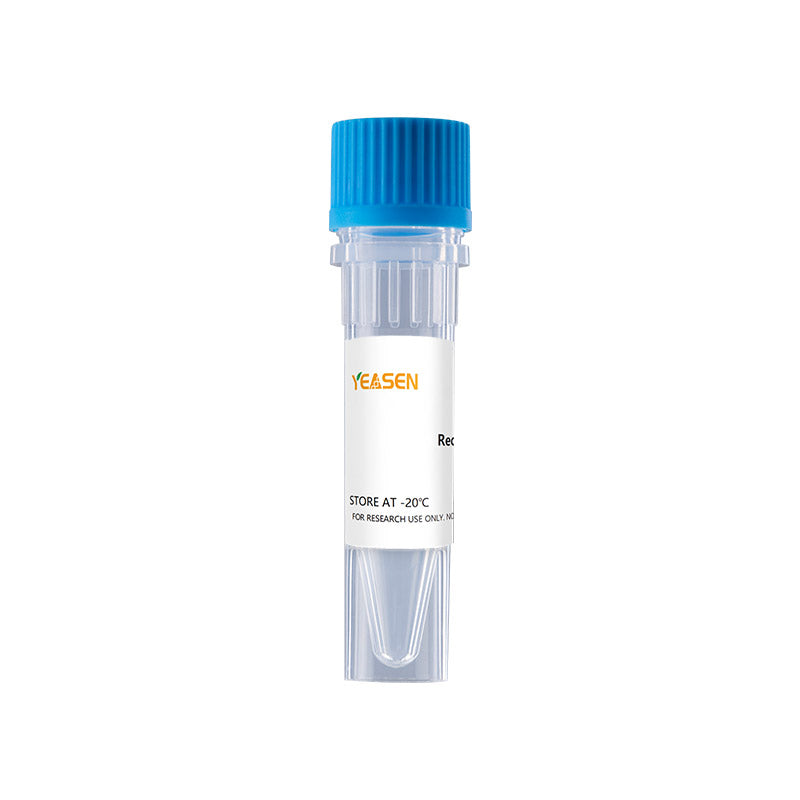Description
APRIL (a proliferation-inducing ligand), also known as TNFSF13, TALL2, TRDL1, and CD256, is a member of the TNF ligand superfamily. It is synthesized as a 32 kDa proprotein which is cleaved by furin in the Golgi to release the active 17 kDa soluble molecule. Secreted human APRIL, which consists almost entirely of a single TNF homology domain, shares 85% amino acid sequence identity with mouse and rat APRIL. Both APRIL and its close relative BAFF bind and signal through the TNF superfamily receptors TACI and BCMA, while BAFF additionally functions through BAFF R. APRIL binds to heparan sulfate proteoglycans (HSPGs) independently of its binding to TACI and BCMA. The interaction with HSPGs induces APRIL oligomerization, and this augments TACI-, or BMCA-mediated effects. HSPGs are also critical for the tumor growth-promoting effects attributed to APRIL. APRIL can form bioactive heterotrimers with BAFF, and these circulate in the serum of patients with rheumatic immune disorders. TWE-PRIL is a bioactive hybrid protein produced by gene splicing. It consists of the intracellular domain, transmembrane segment, and stalk region of TWEAK fused to the TNF homology domain of APRIL. TWE-PRIL is expressed in monocytes and activated T cells and, in contrast to APRIL, is presented on the cell surface. APRIL enhances the proliferation and survival of plasma cells and also promotes T cell-dependent humoral responses.
Product Properties
|
Synonyms |
APRIL,CD256 |
|
Accession |
Q9D777 |
|
GeneID |
69583 |
|
Source |
E.coli-derived Mouse sAPRIL/TNFSF13, Ala96-Leu241. |
|
Molecular Weight |
Approximately 16.4 kDa. |
|
AA Sequence |
AVLTQKHKKK HSVLHLVPVN ITSKADSDVT EVMWQPVLRR GRGLEAQGDI VRVWDTGIYL LYSQVLFHDV TFTMGQVVSR EGQGRRETLF RCIRSMPSDP DRAYNSCYSA GVFHLHQGDI ITVKIPRANA KLSLSPHGTF LGFVKL |
|
Tag |
None |
|
Physical Appearance |
Sterile Filtered White lyophilized (freeze-dried) powder. |
|
Purity |
> 95 % by SDS-PAGE and HPLC analyses. |
|
Biological Activity |
The ED50 as determined by a cell proliferation assay using activated T cells. Fully biologically active when compared to standard. |
|
Endotoxin |
< 0.1 EU per 1μg of the protein by the LAL method. |
|
Formulation |
Lyophilized from a 0.2 µm filtered concentrated solution in PBS, pH 7.4, with 0.02 % Tween-20. |
|
Reconstitution |
We recommend that this vial be briefly centrifuged prior to opening to bring the contents to the bottom. Reconstitute in sterile distilled water or aqueous buffer containing 0.1% BSA to a concentration of 0.1-1.0 mg/mL. Stock solutions should be apportioned into working aliquots and stored at ≤ -20℃. Further dilutions should be made in appropriate buffered solutions. |
Shipping and Storage
The products are shipped with ice pack and can be stored at -20℃ to -80℃ for 1 year.
Recommend to aliquot the protein into smaller quantities when first used and avoid repeated freeze-thaw cycles.
Cautions
1. Avoid repeated freeze-thaw cycles.
2. For your safety and health, please wear lab coats and disposable gloves for operation.
3. For research use only!
Payment & Security
Your payment information is processed securely. We do not store credit card details nor have access to your credit card information.
Inquiry
You may also like
FAQ
The product is for research purposes only and is not intended for therapeutic or diagnostic use in humans or animals. Products and content are protected by patents, trademarks, and copyrights owned by Yeasen Biotechnology. Trademark symbols indicate the country of origin, not necessarily registration in all regions.
Certain applications may require additional third-party intellectual property rights.
Yeasen is dedicated to ethical science, believing our research should address critical questions while ensuring safety and ethical standards.

